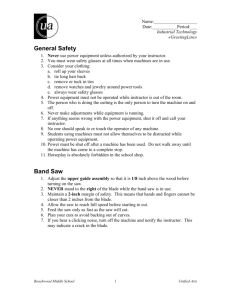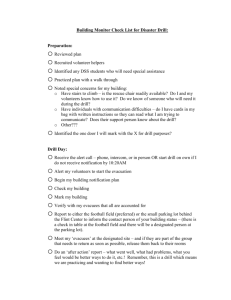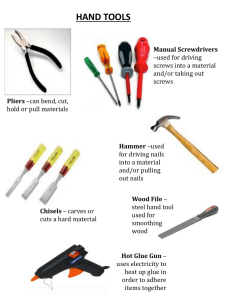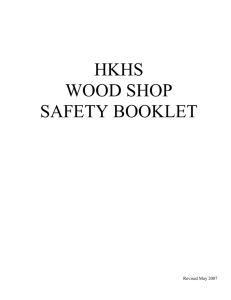Band Saw, Drill Press, Sander Safety Instructions
advertisement
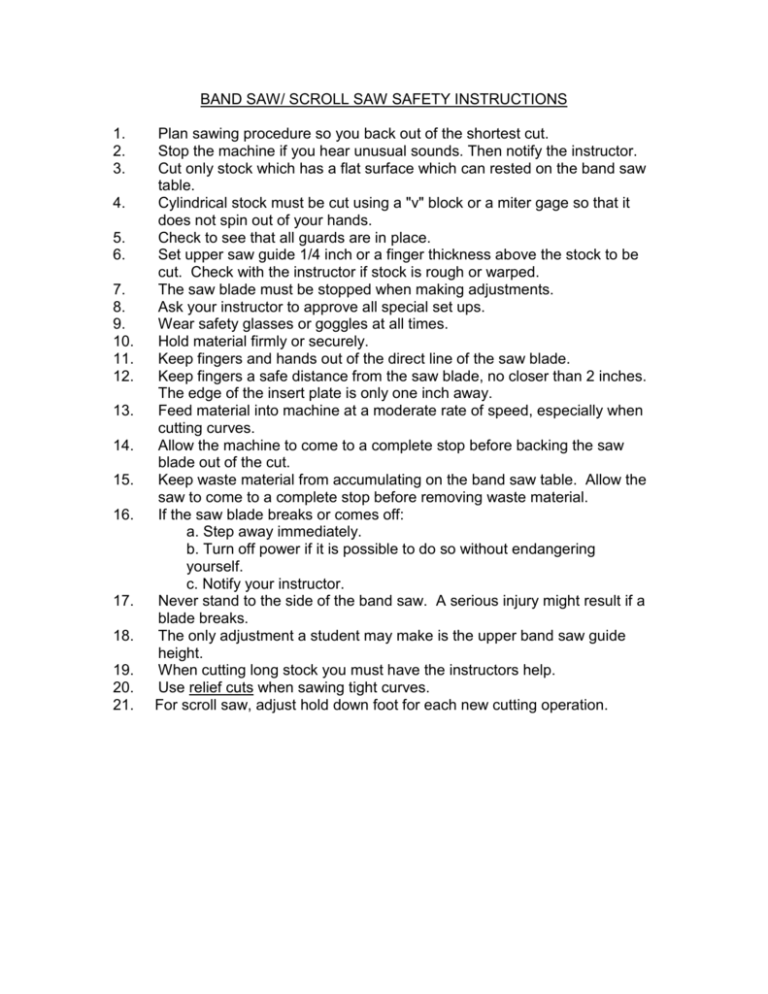
BAND SAW/ SCROLL SAW SAFETY INSTRUCTIONS 1. 2. 3. 4. 5. 6. 7. 8. 9. 10. 11. 12. 13. 14. 15. 16. 17. 18. 19. 20. 21. Plan sawing procedure so you back out of the shortest cut. Stop the machine if you hear unusual sounds. Then notify the instructor. Cut only stock which has a flat surface which can rested on the band saw table. Cylindrical stock must be cut using a "v" block or a miter gage so that it does not spin out of your hands. Check to see that all guards are in place. Set upper saw guide 1/4 inch or a finger thickness above the stock to be cut. Check with the instructor if stock is rough or warped. The saw blade must be stopped when making adjustments. Ask your instructor to approve all special set ups. Wear safety glasses or goggles at all times. Hold material firmly or securely. Keep fingers and hands out of the direct line of the saw blade. Keep fingers a safe distance from the saw blade, no closer than 2 inches. The edge of the insert plate is only one inch away. Feed material into machine at a moderate rate of speed, especially when cutting curves. Allow the machine to come to a complete stop before backing the saw blade out of the cut. Keep waste material from accumulating on the band saw table. Allow the saw to come to a complete stop before removing waste material. If the saw blade breaks or comes off: a. Step away immediately. b. Turn off power if it is possible to do so without endangering yourself. c. Notify your instructor. Never stand to the side of the band saw. A serious injury might result if a blade breaks. The only adjustment a student may make is the upper band saw guide height. When cutting long stock you must have the instructors help. Use relief cuts when sawing tight curves. For scroll saw, adjust hold down foot for each new cutting operation. Drill Press Safety Rules 1. 2. 3. 4. 5. 6. 7. 8. 9. 10. 11. 12. 13. 14. 15. The work piece must be clamped in the vise or fastened to the table if the work piece is small, you are drilling large holes, or you are drilling metal. If the drill bit catches and grabs the work from your hand, a severe injury may result. Remove chips and shavings with a brush or piece of wood, never with your hands or a rag. Keep your fingers away from the drill bit when the drill press is on. Keep hair, fingers, jewelry, and loose clothing away from all moving parts of the drill press. Check the machine to see that the chuck key, tools, and other accessories are removed from the table before turning the power on. Use saw dust to clean up oil on or around the drill press. When using a vise, operate the drill press in such a way that the drill will not damage the vise or table. Use drill bits which are properly sharpened and which are the correct size. When the drill bit begins to break through the material, ease up on the feed pressure so that the drill bit won't grab the work piece. The drill press has a safety zone marked off on the floor with black and yellow striped tape. No one, other than the one person using the drill press and the instructor, may be inside the safety zone during drilling operation. If possible, secure the material in such a way that any overhang of the table is on the operator's left side. Always use a backing board on the drill press table to avoid damage to the table. Use only sufficient feed pressure to allow the drill to cut evenly into the material. Do not stop the drill press by using your hand. If the work is seized or starts to spin: a. Step away immediately. b. Turn off power if it is possible to do so without endangering yourself. c. Notify your instructor. Sanders Safety Rules Hand Held Sanders 1. Keep both hands on the hand held sander. This makes it impossible to feel the sanded surface while sanding which would endanger your hand. 2. Arrange the electric cord of the sander so that it cannot be caught by the abrasive paper. 3. Hold on to the handle of the sander when you plug it into the electrical outlet. 5. Unplug the portable sander from the outlet when changing abrasive belts or sheets. 6. Fasten the board or project securely. Belt/Disc Sanders 1. Check sanding belt or disc for breaks or tears. 2. Keep fingers away from abrasive surfaces of sanders; never attempt to stop the sander with your hands. 3. Sand against the rotation of the belt and on the down side of a disc sander. 4. Hold work securely. 5. Turn off the disc/belt sander after use. 6. Do not make any adjustments on the sanders. 7. Keep fingers and hands away from the belt or disc. DO NOT clear sawdust from the table with the hands; use a brush. On small or thin parts, use a push stick or jig to keep the hands from contacting the abrasive. If using the optional fence, avoid getting fingers too close to the fence to prevent pinching. Never wear gloves while operating the sander.
